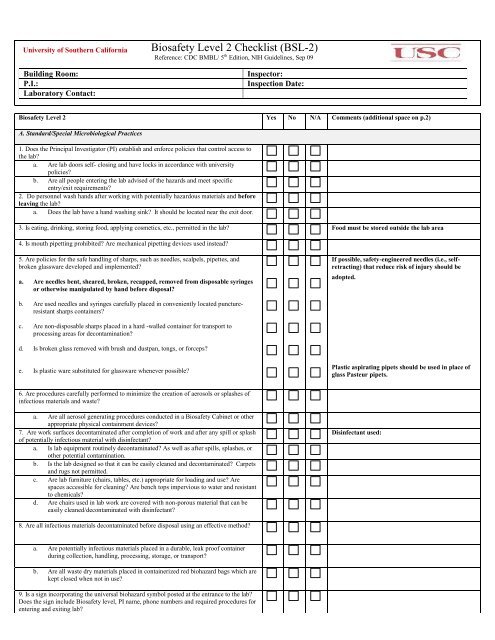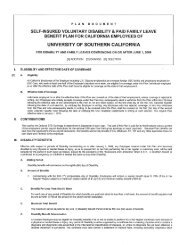Biosafety Level 2 inspection checklist - University of Southern ...
Biosafety Level 2 inspection checklist - University of Southern ...
Biosafety Level 2 inspection checklist - University of Southern ...
Create successful ePaper yourself
Turn your PDF publications into a flip-book with our unique Google optimized e-Paper software.
<strong>University</strong> <strong>of</strong> <strong>Southern</strong> California<br />
<strong>Biosafety</strong> <strong>Level</strong> 2 Checklist (BSL-2)<br />
Reference: CDC BMBL/ 5 th Edition, NIH Guidelines, Sep 09<br />
Building Room: Inspector:<br />
P.I.: Inspection Date:<br />
Laboratory Contact:<br />
<strong>Biosafety</strong> <strong>Level</strong> 2 Yes No N/A Comments (additional space on p.2)<br />
A. Standard/Special Microbiological Practices<br />
1. Does the Principal Investigator (PI) establish and enforce policies that control access to<br />
the lab?<br />
a. Are lab doors self- closing and have locks in accordance with university<br />
policies?<br />
b. Are all people entering the lab advised <strong>of</strong> the hazards and meet specific<br />
entry/exit requirements?<br />
2. Do personnel wash hands after working with potentially hazardous materials and before<br />
leaving the lab?<br />
a. Does the lab have a hand washing sink? It should be located near the exit door.<br />
3. Is eating, drinking, storing food, applying cosmetics, etc., permitted in the lab? Food must be stored outside the lab area<br />
4. Is mouth pipetting prohibited? Are mechanical pipetting devices used instead?<br />
5. Are policies for the safe handling <strong>of</strong> sharps, such as needles, scalpels, pipettes, and<br />
broken glassware developed and implemented?<br />
a. Are needles bent, sheared, broken, recapped, removed from disposable syringes<br />
or otherwise manipulated by hand before disposal?<br />
b. Are used needles and syringes carefully placed in conveniently located punctureresistant<br />
sharps containers?<br />
c. Are non-disposable sharps placed in a hard -walled container for transport to<br />
processing areas for decontamination?<br />
d. Is broken glass removed with brush and dustpan, tongs, or forceps?<br />
e. Is plastic ware substituted for glassware whenever possible?<br />
6. Are procedures carefully performed to minimize the creation <strong>of</strong> aerosols or splashes <strong>of</strong><br />
infectious materials and waste?<br />
a. Are all aerosol generating procedures conducted in a <strong>Biosafety</strong> Cabinet or other<br />
appropriate physical containment devices?<br />
7. Are work surfaces decontaminated after completion <strong>of</strong> work and after any spill or splash<br />
<strong>of</strong> potentially infectious material with disinfectant?<br />
a. Is lab equipment routinely decontaminated? As well as after spills, splashes, or<br />
other potential contamination.<br />
b. Is the lab designed so that it can be easily cleaned and decontaminated? Carpets<br />
and rugs not permitted.<br />
c. Are lab furniture (chairs, tables, etc.) appropriate for loading and use? Are<br />
spaces accessible for cleaning? Are bench tops impervious to water and resistant<br />
to chemicals?<br />
d. Are chairs used in lab work are covered with non-porous material that can be<br />
easily cleaned/decontaminated with disinfectant?<br />
8. Are all infectious materials decontaminated before disposal using an effective method?<br />
a. Are potentially infectious materials placed in a durable, leak pro<strong>of</strong> container<br />
during collection, handling, processing, storage, or transport?<br />
b. Are all waste dry materials placed in containerized red biohazard bags which are<br />
kept closed when not in use?<br />
9. Is a sign incorporating the universal biohazard symbol posted at the entrance to the lab?<br />
Does the sign include <strong>Biosafety</strong> level, PI name, phone numbers and required procedures for<br />
entering and exiting lab?<br />
If possible, safety-engineered needles (i.e., selfretracting)<br />
that reduce risk <strong>of</strong> injury should be<br />
adopted.<br />
Plastic aspirating pipets should be used in place <strong>of</strong><br />
glass Pasteur pipets.<br />
Disinfectant used:
10. Have you had any issues with insect or rodent control?<br />
11. Does PI ensure that lab personnel receive appropriate training regarding their duties,<br />
precautions to prevent exposures and exposure evaluation procedures?<br />
a. Is Annual refresher training documented?<br />
b. Are all lab personnel and particularly women <strong>of</strong> childbearing age provided info<br />
regarding immune competence and conditions that may predispose them to<br />
infection? (Individuals having these conditions are encouraged to selfidentify<br />
to university medical surveillance provider for appropriate<br />
counseling and guidance).<br />
B. Special Practices<br />
1. Are all persons authorized to enter the lab advised <strong>of</strong> potential hazards; are lab personnel<br />
provided medical surveillance and <strong>of</strong>fered appropriate immunizations (i.e., Hepatitis B) for<br />
agents handled in the lab?<br />
2. Are Laboratory specific biosafety manual/Standard Operating Procedures (SOP)<br />
prepared and adopted as policy? Is it available and accessible?<br />
3. Does the PI ensure that lab personnel demonstrate pr<strong>of</strong>iciency with standard and<br />
specialized BSL-2 microbiological practices before working with these agents?<br />
a. If both high hazard and low hazard experiments are conducted in your lab, are<br />
those areas in your lab reserved for experiments <strong>of</strong> lesser biohazard potential<br />
carefully demarcated from higher biohazard areas?<br />
4. Are personnel routinely decontaminating lab equipment, or when the equipment requires<br />
repair, maintenance, or removal from the lab?<br />
If spills occur, are staff properly trained and equipped to work with infectious material?<br />
4. If a laboratory exposure should occur, are there written procedures or emergency<br />
information available and accessible in the laboratory?<br />
a. All such incidents must be reported to the PI. PI must also report incidents<br />
immediately to Workers’ Comp (213-740-6205) and the <strong>Biosafety</strong> Office (323-442-<br />
2200).<br />
b. Medical evaluation, surveillance, and treatment should be provided when required and<br />
appropriate records maintained.<br />
5. Are animals and plants not associated with the work being performed permitted in the<br />
lab?<br />
C. Safety Equipment (Primary Barriers)<br />
1. Are <strong>Biosafety</strong> cabinet (Class II), certified annually, and other containment devices or PPE<br />
used when:<br />
a. Potential for aerosols or splashes exists? These may include centrifuging, grinding,<br />
blending, inoculating animals intranasally, harvesting infected tissues, etc.<br />
b. High concentrations/titers or large volumes <strong>of</strong> agents are used? These may be<br />
centrifuged outside the BSC using sealed rotor heads or centrifuge safety cups.<br />
2. Are lab coats/gowns/smocks/ worn when in lab, and removed prior to leaving lab (i.e.,<br />
before leaving for cafeteria, library, and administrative <strong>of</strong>fices)? Dispose <strong>of</strong> protective<br />
clothing appropriately or deposit for laundering by institution (lab coats must not be taken<br />
home).<br />
3. Are eye and face protection (goggles, mask, face shield or other splatter guard) used for<br />
work outside biosafety cabinet that may generate splashes or sprays?<br />
4. Are gloves worn to protect hands from exposure to agents? Glove selection should be<br />
based on risk assessment. Disposable gloves must not be washed or reused. Gloves must be<br />
removed and disposed as biohazardous waste prior to leaving lab. Alternatives to latex<br />
should be available.<br />
5. Are eye, face, and respiratory protection used in rooms containing infected animals as<br />
determined by risk assessment?<br />
D. Laboratory Facilities (Secondary Barriers)<br />
1. Do the lab windows open to exterior? If a lab does have such windows, they must be<br />
fitted with screens or a sign posted that states “Windows must remain closed.”<br />
2. Is the BSC installed properly to avoid room air fluctuations that might impede proper<br />
functioning <strong>of</strong> the cabinet?<br />
3. Are vacuum lines protected with liquid disinfectant traps?<br />
4. Are vacuum lines protected with HEPA (High Efficiency Particulate Air) filters?<br />
5. Is the eyewash station readily available? Portable eye wash bottle may be used if eyewash<br />
station is not available.<br />
Incidents that may result in exposure to infectious<br />
materials must be immediately evaluated and<br />
treated according to USC established<br />
procedures.
6. HEPA filtered exhaust air from a Class II BSC can be safely recirculated if cabinet is<br />
tested and certified annually, see here for vendors:<br />
http://capsnet.usc.edu/LabSafety/BioSafety/BioSafeyCabinets/BSCVendors.cfm<br />
Personnel Training Yes No N/A Comments<br />
Documented lab safety training (i.e., Safety refresher training conducted within the last<br />
year, with sign-in sheet available?)<br />
Documented bloodborne pathogens training (required annually if working with human cell<br />
lines, tissue, blood, or other human-derived materials)?<br />
ADDITIONAL COMMENTS:<br />
BSC Certification Date:<br />
The Principal Investigator is responsible for full compliance with the policies, practices and procedures set forth in the <strong>Biosafety</strong> in<br />
Microbiological and Biomedical Laboratories – 5 th Edition. The PI is responsible for assuring the appropriate training <strong>of</strong> employees and for<br />
correcting errors and unsafe working conditions.<br />
PI Signature (Mandatory) _____________________________________ Date_________________<br />
Laboratory Manager (if form prepared by) ________________________ Date_________________













